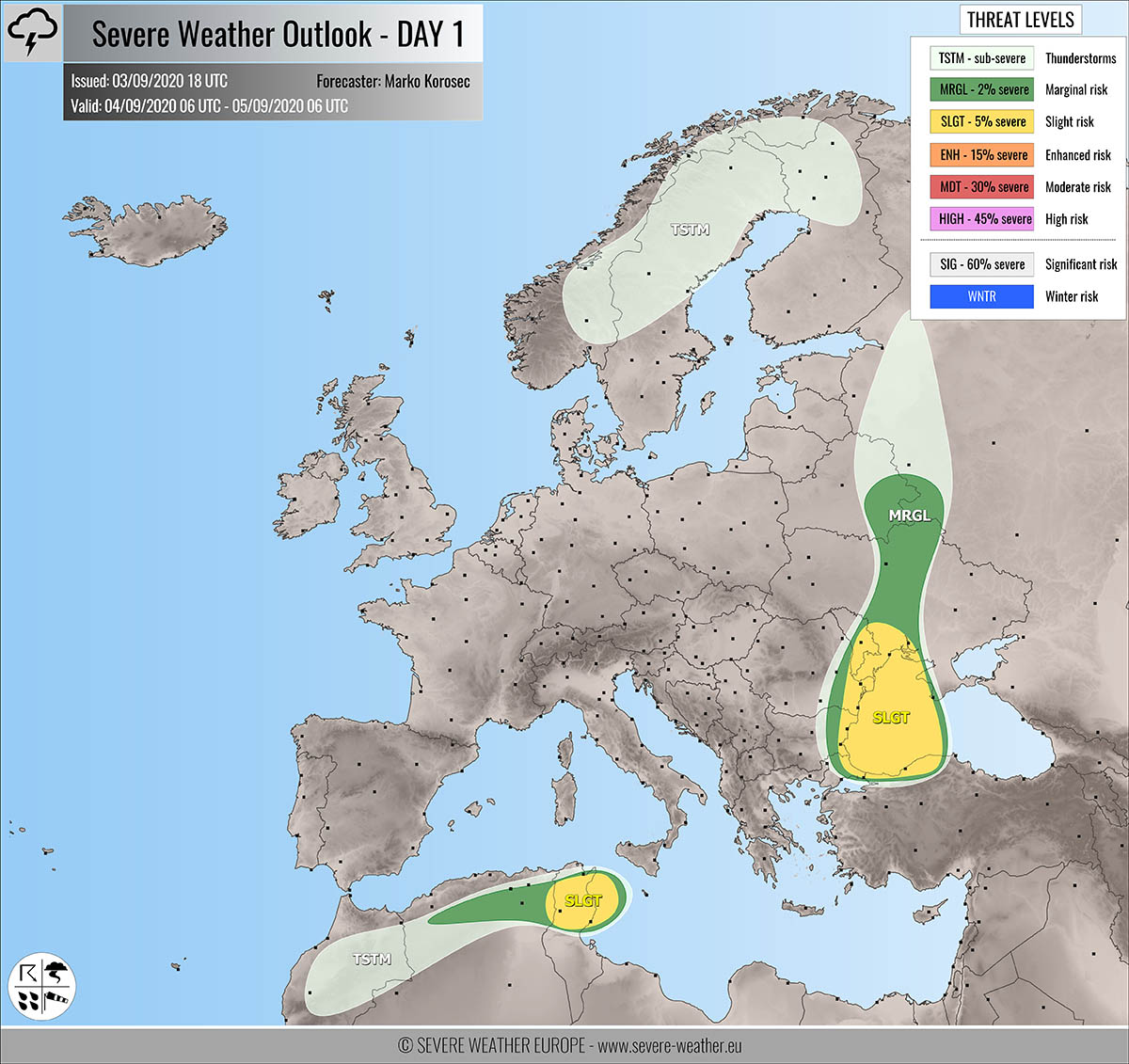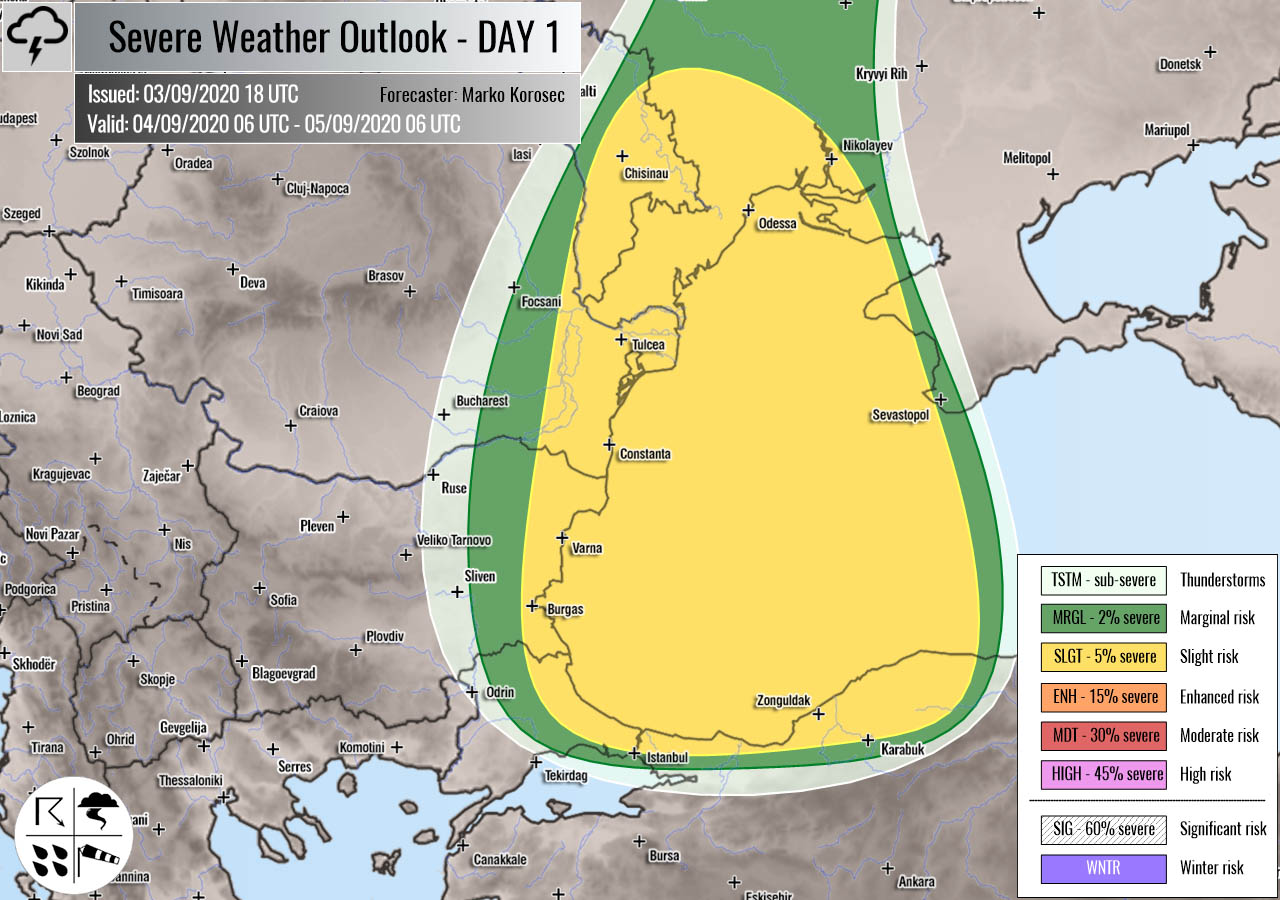Severe weather outlook – forecast across Europe. This forecast features areas of organized severe weather with risk levels and severe weather threats across the European continent.
SEVERE WEATHER OUTLOOK – DAY 1
Valid: 04/09/2020 06 UTC – 05/09/2020 06 UTC
Issued by: Severe Weather Europe
Forecaster: Marko Korošec
SUMMARY
Severe storms with large hail, severe winds, and torrential rainfall are possible across part of the Balkan peninsula on Friday. Isolated severe storms are possible over Tunisia.
Overview of the risk areas across Europe
SYNOPTIC OVERVIEW
A ridging pattern is dominating much of Europe, while three features are the main trigger for convective storms on Friday. A large trough moving into northern Europe and two upper low further south. One upper low in weakening over Tunisia, while the upper low over the Black Sea begins strengthening.
FORECAST DISCUSSION
+++ Romania, Bulgaria, Moldova, Ukraine, Black Sea and Turkey +++
SLGT risk has been issued for eastern Bulgaria, southeast Romania into southern Moldova, southwestern Ukraine, and northern Turkey into the Black Sea with a threat for severe storms, capable of producing severe winds, torrential rainfall, and marginal hail.
Scattered severe storms are again possible along with the weakening frontal system. A good overlap of shear and instability could support a few supercells with large hail and severe winds threat.
A cluster of storms is likely to track along the front into the Black Sea in the evening hours.
+++ Tunisia +++
SLGT risk has been issued for northern Tunisia with a threat for severe storms, capable of producing severe winds, torrential rainfall, and marginal hail.
Isolated storms are possible within a strongly unstable and sheared environment, associated with the weak upper low. A supercell or two will be possible, mainly with large hail and severe winds threat.
+++ other areas +++
TSTM risks have been issued for northern Algeria, Morocco, and part of Scandinavia with a threat for daytime driven storms. Limited shear is present, so the storms should remain sub-severe.
Follow & report severe weather events on our Facebook page:
Severe Weather Europe Facebook page
Understanding Severe Weather Outlook
Severe Weather Outlook features areas of organized severe weather with risk levels and severe weather threats. Risk levels are divided into seven categories:
TSTM – Thunderstorms
MRGL – Marginal risk
SLGT – Slight risk
ENH – Enhanced risk
MDT – Moderate risk
HIGH – High risk
SIG – Significant risk
WNTR – Winter risk
Risk categories stand for the coverage and intensity of organized severe weather. Those could include supercells, squall lines, mesoscale convective systems, wind storms, flooding, snowstorms, or ice storms.
Severe weather threats include:
- large hail (of at least 2 cm in diameter)
- Tornadoes (including waterspouts)
- Wind gusts (convective or non-convective) above 25 m/s (or above 90 km/h)
- Torrential convective precipitation / Flash floods
- Excessive rainfall (100 mm within 12 hours) / snowfall (50 cm within 12 hours)
Extremely severe weather threats include:
- Large hail (of at least 5 cm in diameter)
- Tornadoes of F2 intensity or stronger
- Wind gusts (convective or non-convective) above 33 m/s (or above 119 km/h) or 12 Bft
- Torrential convective precipitation / Flash floods
- Excessive rainfall (150 mm within 12 hours or above ) / snowfall (above 100 cm within 24 hours)
Categories in the forecast represent the chance of severe weather occurring within a 40 km radius from a location. The used level is based on the conversion table of probabilistic risk into the outlook categories. A threat level is upgraded into a higher category if probabilities meet the threshold criteria for the specific threat (e.g. tornado, wind, hail, or rainfall threat).
Each individual threat area includes a detailed forecast map and discussion on the potential of severe weather threats.
Read more: Explanations for abbreviations (TSTM, SLGT, ENH, etc.)


